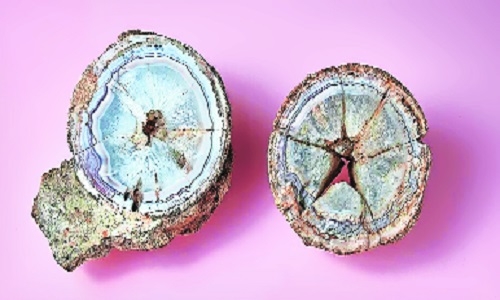‘Ball’ at British museum turns out to be dinosaur egg from Central India
| Date :23-Apr-2024 |

By Shirish Borkar
IT’S a classic case of discovery within discovery! An agate ‘ball’ from India’s erstwhile Central Province & Berar curated within the collection due to its high aesthetic value at the Natural History Museum (NHM), London, United Kingdom (UK), which remained unrecognised for almost 140 years, has turned out to be a fossilised egg of a dinosaur. This egg was donated to NHM, London, in 1883 by Charles Fraser who was the Commissioner of Sagar and Narmada territories, in Central India. Fraser was a member of the Bengal Service of the British East India Company and removed several fossils from India including mammalian fossils from Narmada valley to England. Dr D M Mohabey, Nagpur-based Internationally acclaimed palaeontologist and former Director General of Geological Survey of India, who is putting in sincere efforts to bring back the dinosaur egg from NHM, London, along with other dinosaur fossil bones taken there from India during pre-Independence, confirmed that detailed scrutiny of the agate ‘ball’ led to this astonishing discovery. The egg belonged to a titanosaurian sauropod dinosaur, he added.
Robin F Hansen, Curator, Minerals and Gemstones, and Paul M Barrett, Dinosaur Researcher and Head of Fossil Vertebrates, of NHM London, have also published about the discovery that had remained unrecognised for so many years in the UK-based Geological Curators Group’s journal recently. Dr Mohabey, who discovered hundreds of fossilised eggs, bones, nests, coprolites and other skeletal remains of dinosaurs in Lameta formation, said parts of Gujarat, Madhya Pradesh and Vidarbha in Maharashtra were the home of these ‘terrible lizards’ some 67 million years ago. “It is unfortunate that in spite of the exhaustive research on the museum archives by Hansen and Barrett the exact locality of the agate ‘ball’ remains unknown. It is our now concern that we should be able to find the locality,” says Dr Mohabey, while talking to ‘The Hitavada’. The first recorded dinosaur fossil in India was discovered by Colonel W H Sleeman of the Bengal Army in 1828 from Jabalpur. Dr Mohabey had discovered hundreds of fossilised eggs and nests of dinosaurs in Lameta formation at Mahisagar (Kheda) district of Gujarat in 1981.
Dr Mohabey along with G N Dwivedi (GSI) had also discovered hundreds of fossilised bones and other skeletal remains of Sauropods (quadruped lizard-hipped Titanosaurs -- herbivorous dinosaurs) and Theropods (Abelisaurus -- Carnivorous dinosaurs) from the same site which is unique in the world. The site also has hatcheries and ‘graveyard’ of dinosaurs. Similarly, he had also discovered bones, coprolites, and other skeletal remains of dinosaurs from Pisdura, taluka Warora in Chandrapur district (Maharashtra) and Jabalpur (Madhya Pradesh). These dinosaurs lived contemporarily with giant herbivore titanosaurs, large sized carnivore hunters like Abelisaurid theropods, Madtsoiidae snakes, large side necked turtles and crocodiles under semi arid climate.
Pisdura is a unique locality in the world that prolifically yielded coprolites (fossilised dung of sauropod dinosaurs). Discovered and studied by Dr Mohabey, these plant bearing coprolites contain soft tissues of angiospermic and pteridophytic plants. These coprolites suggested that these sauropods preferred soft tissues of plants as their solid diet 67 million years back. “I’m now trying to find out from which place in Central India the agatised egg of the dinosaur kept in NHM, London, was found by Charles Fraser,” Dr Mohabey says, adding that, “I’m in touch with curator Paul Barrett for further studies.”